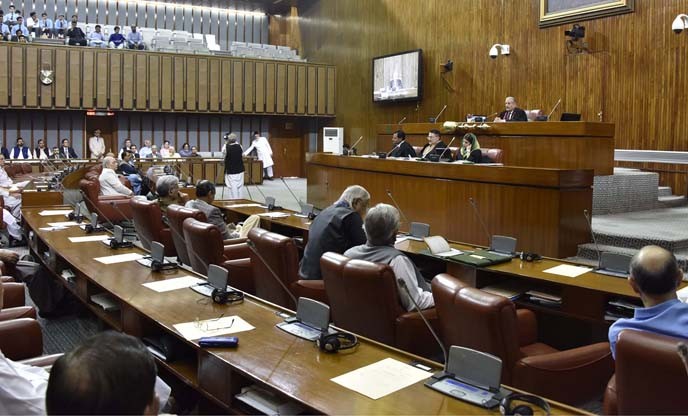
Transfer of five key regulatory authorities form the cabinet division to ministries has stirred a constitutional debate

The government’s recent move to reallocate the administrative control of five key regulatory authorities form the cabinet division to the respective line ministries has stirred a constitutional debate in the Upper House, the Senate of Pakistan.
Senators from treasury and opposition benches have been opposing interpretations of the decision made by the prime minister on December 19. The government claims that it has made the decision within the lawful executive authority of the prime minister in line with the rules of business; while opposition terms it an ‘unconstitutional act’ violating the intent of legislatures reflected through the consensus-based 18th Constitutional Amendment.
Let’s first see what the 18th Amendment has to do with the ongoing conflict of interpretations on the control of regulatory authorities between the government and the opposition. Primarily, the 18th Amendment has re-demarcated the jurisdictions of Pakistan’s multi-level governance at the federal, inter-provincial and provincial levels by revising the Federal Legislative List Part I and Part II and abolishing the erstwhile Concurrent Legislative List (CLL).
Subsequently, the legislative and executive authorities of the federal and provincial governments have been delimited by assigning the exclusivity of 53 subjects to the federal government, 18 subjects to the Council of Common Interests (CCI) and all residual subjects to the provincial governments. Further redistribution of functions at the district, tehsil and union council levels has been vested with the provincial governments in accordance with the policy framework enunciated in Article 140 (A) of the Constitution.
All the federal regulatory authorities established by federal law are enumerated at entry no 6 in the FLL-II. The FLL-II is governed by Article 154 of the Constitution which reads: "The Council [of Common Interests] shall formulate and regulate policies in relation to matters in Part II of the Federal Legislative List and shall exercise supervision and control over related institutions."
‘Regulate’, ‘supervise’ and ‘control’ are the key three words used in this Article which re-defined the jurisdictional outreach of the CCI. The intent of legislatures behind these words is conceivably understood by giving the policy, regulatory and supervisory control of the subjects mentioned in FLL-II to the CCI which is represented by five governments through the prime minister and chief ministers.
The case in question appears to be the violation of Article 154 as the prime minister issued a unilateral direction on the subject which does not fall within the exclusive executive domain of the federal government per se. Being enumerated in the FLL-II, the regulatory authorities become the subject of joint decision-making with meaningful input from provinces. And this was not complied with in the current case of reallocation of regulatory authorities, therefor, the decision lacks constitutional support.
On the other hand, the government’s spokespersons claim that the memorandum was issued according to rules of business of the federal government. "It had been happening time and again in the past and there is nothing out of ordinary in this memorandum," a government representative explained.
The existing rule of business, however, does not correspond to the spirit of the 18th Amendment with special reference to Article 154 (related to CCI). Fundamentally, the innovation introduced in the form of CCI goes beyond the federal government-heavy decisions making.
The current conflict of interpretation stems from the absence of subordinate legislation and subsequent institutional mechanisms of regulating joint-decision making. These anomalies need to be ratified and RoB needs to be amended in line with the key changes introduced by the 18th Amendment, particularly with reference to the subjects falling within the domain of joint-decision making through CCI.
At political level, this necessitates a culture of shared responsibility and joint decision-making between the federal government and provinces. Some key subjects enlisted in the Federal Legislative List-II need to be studied in order to determine as to how the policy, regulatory and supervisory control of these subjects can be governed by the CCI under the framework of shared responsibility and joint control.
Provincial representations in the federal regulatory authorities and mechanism for joint management of electricity, ports, national planning supervision and public debt; and defining standards in higher education are some critical issues which need in-depth policy debates and appropriate decisions. Provincial representation in the management boards of federal entities was demanded by the government of Khyber Pakhtunkhwa, which was supported by other provinces also.
This demand was based on a pro-active interpretation of entry three of the Federal Legislative List II. The matter is yet undecided but presents another example of contest on provincial rights. Due to the absence of the subordinate legislation, both the federal and provincial governments have been claiming authority over decisions related to oil and gas exploration.
Appropriate steps should be taken to develop the institutional design and establish an independent secretariat of the Council of Common Interests (CCI) as provided by the 18th Amendment. The CCI Secretariat should have equal provincial representation in the functioning and management thereof representing all stakeholders’ interests and interpretations on contentious issues like control on regulatory authorities.